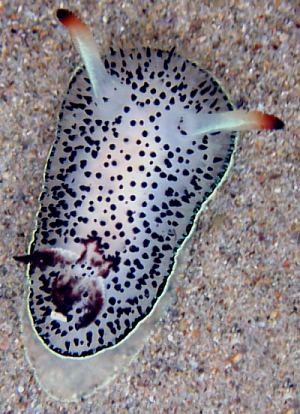
Acanthodoris rhodoceras
Cockerell & Eliot, 1905
Order: NUDIBRANCHIA
Suborder: DORIDINA
Superfamily: ANADORIDOIDEA
Family: Onchidorididae
DISTRIBUTION
West coast of North America - Cape Arago, Oregon to Baja California, Mexico
PHOTO
Coal Oil Point, Santa Barbara, California. Photo: Genevieve Anderson.
Mantle covered in tapering papillae. They are translucent white and sometimes tipped with black. There is a range in variation from those animals in which most of the papillae are black-tipped to those in which none are black-tipped. The edge of the mantle and the foot has a milky crean-yellow border and the mantle also an inner black line. This species grows to 30mm long.
Goddard, (1990) reports it feeding on the bryozoan Alcyonidium sp..
References:
• Cockerell, T.D.A. & Eliot, C.N.E. (1905) Notes on a collection of Californian nudibranchs. Journal of Malacology, 12(3): 31-53, pls. 7-8.
• Behrens, D.W. (1991) Pacific Coast Nudibranchs: a guide to the opisthobranchs, Alaska to Baja California. 107 pp., 217 photos. Second Edition. Sea Challengers: Monterey, California.
• Goddard, J. H. R. 1990. Additional opisthobranch mollusks from Oregon, with a review of deep-water records and observations on the fauna of the south coast. The Veliger, 33(3): 230-237.
Rudman, W.B., 2003 (March 2) Acanthodoris rhodoceras Cockerell & Eliot, 1905. [In] Sea Slug Forum. Australian Museum, Sydney. Available from http://www.seaslugforum.net/find/acanrhod
Related messages
Is this Acanthodoris brunnea?
July 11, 2007
From: Steve Lonhart
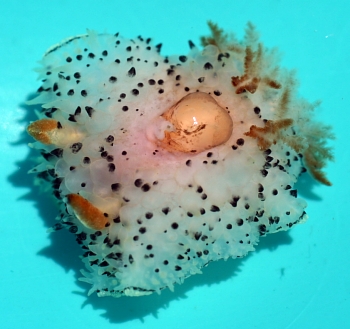
Hi Bill,
This was pulled up from a very sandy area in front of Moss Landing, California, USA. It was not brown, but has other features of Acanthodoris brunnea. There is also a damaged area--not sure if that is part of the gut poking through. There were several of these in the area. I brought it to the lab to photograph (hence the odd background color).
Locality: Moss Landing, 70 feet, California, USA, Pacific Ocean, 22 June 2007, Subtidal, sandy slope. Length: 30 mm. Photographer: S.I. Lonhart.
Cheers,
Steve
Steve.Lonhart@noaa.gov
Lonhart, S.I., 2007 (Jul 11) Is this Acanthodoris brunnea?. [Message in] Sea Slug Forum. Australian Museum, Sydney. Available from http://www.seaslugforum.net/find/20128Hi Steve,
Your critter is actually Acanthodoris rhodoceras. The reddish bown rhinophores, tipped in black, and the black tipped papillations on the dorsum give this species away.
Hope this helps,
Dave Behrens
Acanthodoris species in California
September 6, 2006
From: Kevin Lee
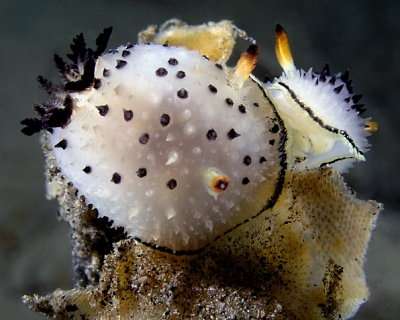
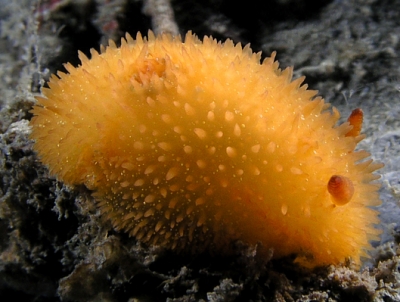
Hi Doc,
The past month seems to belong to the genus Acanthodoris, at La Jolla Shores, California. In several years of diving, I've not seen a single one, but in the span of a few weeks, I've bumped into three. In order, I believe they are:
Acanthodoris rhodoceras,
Acanthodoris lutea, and
Acanthodoris hudsoni.
Your confirmation would be appreciated.
Locality: La Jolla Shores Canyons (North and Main), 35fsw, 70fsw, 30fsw respectively, California, USA, Eastern Pacific, 27 July 2006; 24 August 2006; 27 August 2006, Sandy bottom. Length: approx. 2 cm each. Photographer: Kevin Lee.
Thanks and best wishes,
K:-)
diverkevin@gmail.com
Kevin Lee, 2006 (Sep 6) Acanthodoris species in California. [Message in] Sea Slug Forum. Australian Museum, Sydney. Available from http://www.seaslugforum.net/find/17690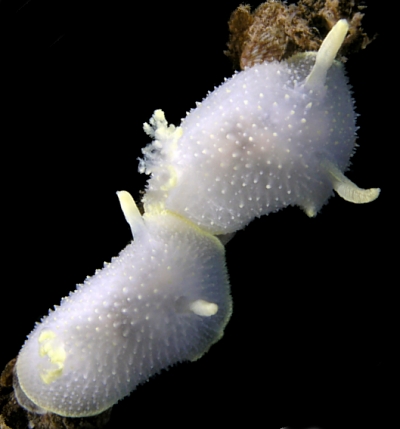
Hi Kevin,
Yes - you are correct on all three ID's in the order you gave them. It is interesting to see such diversity in a single genus at one time. I am also aware that Acanthodoris brunnea has been observed from La Jolla Shores recently (see the Slug Site next week for a recap). Since Acanthodorids feed on bryozoans, as clearly shown in your top photo, this food resource must be quite plentiful to support such diversity.
Best wishes,
Dave Behrens
Re: Acanthodoris rhodoceras from California
August 11, 2006
From: Ken-ichi Ueda
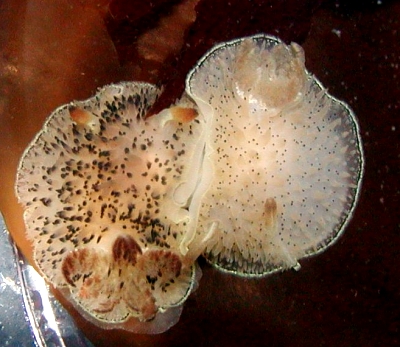
Concerning message #17213:
Those are some great pics. I too saw this species for the first time this summer, though I saw much larger specimens. When I put two in the same container, they started mating!
While they were mating, I noticed an odd behavior: each one would reach out with a rhinophore and touch its mate, then quickly recoil the rhinophore. Is this behavior common among mating dorids? This was the first time I'd ever seen mating nudibranchs, so I wasn't sure what to make of it. I also saw a different individual laying eggs in the same pool. I'm afraid my pics aren't nearly as nice as Kevin's, but I thought they might be interesting.
Locality: Fitzgerald Marine Reserve, Moss Beach, 0 m, California, USA, Pacific Ocean, 11 July 2006, Rocky intertidal. Length: 4-5 cm. Photographer: Ken-ichi Ueda.
Ken-ichi Ueda
kenichi.ueda@gmail.com
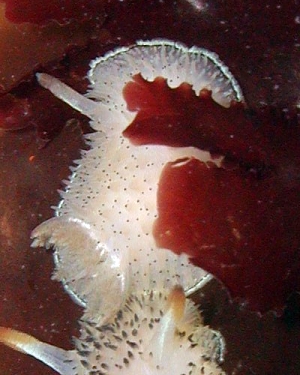
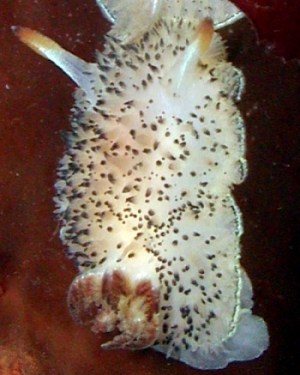
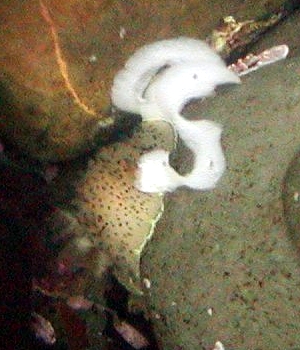
Dear Ken-ichi,
Your photos clearly showing the high degree of color variation in this species.
Concerning your question about rhinophores - interesting observation. Acanthodorids have exceptionally long rhinophores for dorids. I can't remember anyone noting the "touching the mate" behavior before, but lets think about it. The rhinophores are the sensory organs of the critter, and if you wanted to check on identity of your mate, and position yourself for copulation, AND you cannot see, it would make sense to point them in the mates direction, insuring the greatest chemical signal. This would be similar to aiming an antennae in the direction of a radio or TV stations broadcasting antennae.
We always welcome comments from others.
Best wishes,
Dave Behrens
Acanthodoris rhodoceras from California
July 28, 2006
From: Kevin Lee
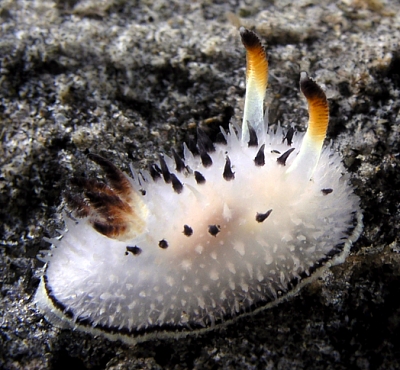
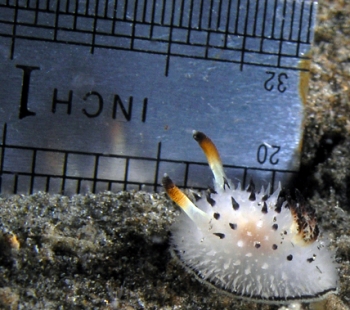
Hi Doc,
Found a first (for me), the diminutive Acanthodoris rhodoceras. Also, used a ruler to show the size. In the future, will use the other side of the rule i.e. metric, instead of imperial standard, to make it easier for you scientists.
Locality: La Jolla Shores Canyon, near North Wall, 60 ft, California, USA, Eastern Pacific, 21 July 2006, Sandy bottom. Length: 0.5 inch. Photographer: Kevin Lee.
All best.
K:-)
diverkevin@gmail.com
Kevin Lee, 2006 (Jul 28) Acanthodoris rhodoceras from California. [Message in] Sea Slug Forum. Australian Museum, Sydney. Available from http://www.seaslugforum.net/find/17213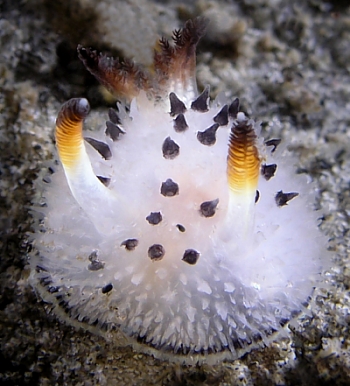
Dear Kevin,
Thanks for these nice photos. Thanks also for thinking of us in terms of measurement. Its not just scientists that use metric, but most of the rest of the world. I find it slightly ironic that more than 200 years after winning a war of independence against the British crown, the USA still uses an 'imperial standard' of measurement.
Best wishes,
Bill Rudman
Acanthodoris rhodoceras from California
June 13, 2005
From: Denise Weisman
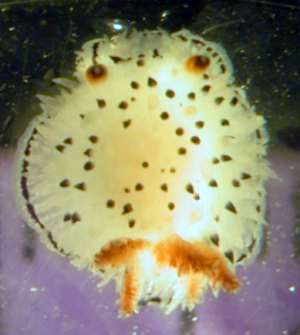
Hello again,
This nudibranch was collected and photographed from the San Clemente Artifical Reef, California.
Locality: San Clemente Artificial Reef, California, USA. Pacific Ocean. Depth: 50 feet. Length: 1 cm. 09 September 2004. Subtidal Photographer: Denise Weisman
Judging from the black tipped dorsal papillae and rhinophores, the black lining of the dorsum and less than 9 branchial plumes, I am thinking this nudibranch is Acanthodoris rhodoceras. However, the tips of the branchial plume are more of an orange rather than the typical black; just a color variation?
Thanks for your help,
Denise Weisman
weisman@lifesci.ucsb.edu
Weisman, D.W., 2005 (Jun 13) Acanthodoris rhodoceras from California. [Message in] Sea Slug Forum. Australian Museum, Sydney. Available from http://www.seaslugforum.net/find/14040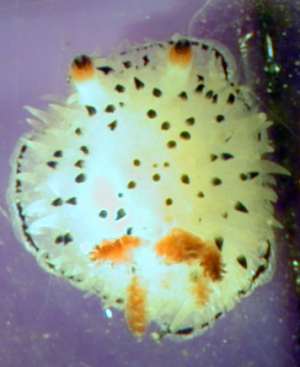
Dear Denise,
This is Acanthodoris rhodoceras. I think the very orange-pink colour of the gills may be to do with a bit of over-exposure in the photograph or it may be that the black pigment is not so well developed in some specimens. There is certainly some black present in some of the gills. In many nudibranchs the gills and rhinophores are similarly coloured, and in this species both orange and black are part of the rhinophore colour pattern and I suspect they are part of the gill colour pattern as well. Probably the black usually maska the orange.
Best wishes,
Bill Rudman
Acanthodoris rhodoceras from California
October 16, 2003
From: Marina Tidwell
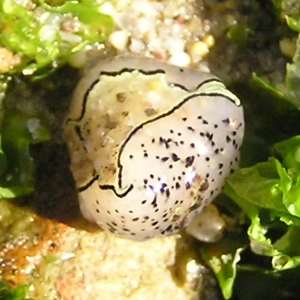
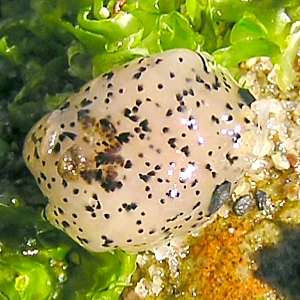
Hi Bill,
My son and I found this little guy in a shallow tidepool close to shore at Leo Carrillo State Beach in Malibu, California yesterday (October 13, 2003). It rolled into a ball when my son picked it up (the picture on the right) and then relaxed and turned right side up. We placed it on the rock to photograph it, but it was just lying on the sand of the pool when first found.
It looks like Archidoris montereyensis except its skin was smooth, it has black or deep green dots instead of rings, and a dark green line (it looks black in the picture) around the circumference of its body.
Any help you can give us would be greatly appreciated.
Thanks!!
Marina Tidwell
mlctidwell@aol.com
Tidwell, M., 2003 (Oct 16) Acanthodoris rhodoceras from California. [Message in] Sea Slug Forum. Australian Museum, Sydney. Available from http://www.seaslugforum.net/find/11251Dear Marina,
I am pretty sure your animal is Acanthodoris rhodoceras. The smooth body and submarginal blackish line around the edge are good clues. Also the blackish dots you describe look to me to be the tips of collapsed papillae. If you look at the species Fact Sheet you will see this species has pointed black-tipped papillae all over the back. These papillae collapse when the animal is taken out of water as you did to photograph it.
I don't think we know very much about this species apart from Goddard's (1990) report that it feeds on a bryozoan of the genus Alcyonidium sp. I presume he is talking about a flattened smooth sponge-like bryozoan, rather than one of the colonies which are often described as 'lace-corals
Best wishes
Bill Rudman
Acanthodoris rhodoceras from California
March 4, 2003
From: Bill Rudman

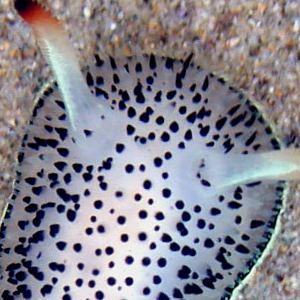
Here is a photo of Acanthodoris rhodoceras which Genny Anderson has given me permission to use from her website on the Californian intertidal at http://www.biosbcc.net/ocean/fltre.htm
It is from Coal Oil Point, Santa Barbara, California.
The lower close-up shows the tapering papillae more clearly.
Bill Rudman
Rudman, W.B., 2003 (Mar 4) Acanthodoris rhodoceras from California. [Message in] Sea Slug Forum. Australian Museum, Sydney. Available from http://www.seaslugforum.net/find/9298